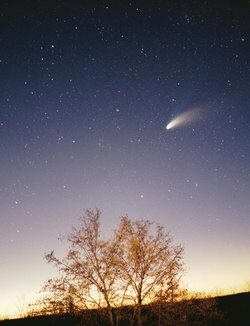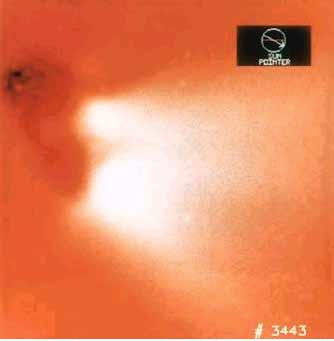|
         
> The Sun
> Mercury
> Venus
> Earth
> Mars
> Jupiter
> Saturn
> Uranus
> Neptune
> Pluto
> The 10th Planet?
> Asteroids
> Comets
> The 'Edge'
  
|
Halley's Comet, perhaps
the most famous of all comets, which reappears approximately every 76
years. It is known to have been seen on 30 separate occasions,
 from 240 bc to
1986. Its next appearance is scheduled for 2061. (These dates refer to the
time at which the comet passed perihelion, the point in its orbit closest
to the Sun.) Although the most recent apparitions, or appearances, have
been disappointing, owing to unfavourable positions of the comet with
respect to the Sun and the Earth, it remains one of the largest and most
active comets known. from 240 bc to
1986. Its next appearance is scheduled for 2061. (These dates refer to the
time at which the comet passed perihelion, the point in its orbit closest
to the Sun.) Although the most recent apparitions, or appearances, have
been disappointing, owing to unfavourable positions of the comet with
respect to the Sun and the Earth, it remains one of the largest and most
active comets known.
Perhaps the best display was that of 837, when the comet emerged suddenly
from the direction of the Sun and approached the Earth to a minimum
distance of less than 6 million km (3.7 million mi). A famous appearance
was that of 1066, which, although presaging defeat in the Battle of
Hastings for the English king, Harold, augured well for the Norman
invader, William. The comet's arrival that year was recorded for posterity
in the Bayeux Tapestry.
The comet is named after the English astronomer Edmond Halley. The theory
of gravitation developed by Isaac Newton was a key ingredient in Halley's
discovery that the bright comet that appeared in 1682 had an orbit that
brought it back to the inner solar system at regular intervals. Previously
there had been three main suggestions concerning the paths of comets: that
they were straight lines, sharply curved parabolas, or greatly elongated
ellipses. Although the question was finally settled for most comets in
favour of parabolic orbits, Halley was foremost in recognizing that an
alternative elliptical solution fitted the observations of the 1682 comet.
This solution was consistent with the observed positions of the comet
appearances of 1456, 1531, and 1607, and Halley was the first to propose
that these apparently different comets were actually the same. Moreover,
by applying Newton's gravitational theory and allowing for the
gravitational effects of Jupiter and Saturn, Halley was able to predict,
successfully, the comet's approximate time of return. It was seen again in
late 1758.
 |
Nucleus of Halley's Comet
In March 1986 the European Space Agency’s
spacecraft Giotto made a close fly-by of Halley’s Comet during its
perihelion passage (the part of its orbit nearest the Sun). Although
Giotto was knocked off course and temporarily disabled by a speck of
dust from the comet travelling at several miles per second, it had
managed to capture the most detailed images of a comet’s nucleus
ever taken. The nucleus is peanut-shaped, and about 16 km (10 mi)
along its longest axis. The top left of the nucleus shows its true
colour, which is very dark; the white arrow in the black box shows
the direction of the Sun, and gases are erupting off the surface
from spots facing in that direction. |
Whether Halley's comet will die with a bang or a whimper is still not
known. Many comets moving in similar orbits end their lives by colliding
with the Sun, while others are ejected from the solar system; a few
collide with the planets, sometimes the Earth. Collisions of cosmic bodies
with planets have profound implications not only for the origin and
evolution of life on Earth but also for our understanding of the formation
and long-term evolution of all the planets in the solar system.
[Back] [Top] [Next] |
 from 240 bc to
1986. Its next appearance is scheduled for 2061. (These dates refer to the
time at which the comet passed perihelion, the point in its orbit closest
to the Sun.) Although the most recent apparitions, or appearances, have
been disappointing, owing to unfavourable positions of the comet with
respect to the Sun and the Earth, it remains one of the largest and most
active comets known.
from 240 bc to
1986. Its next appearance is scheduled for 2061. (These dates refer to the
time at which the comet passed perihelion, the point in its orbit closest
to the Sun.) Although the most recent apparitions, or appearances, have
been disappointing, owing to unfavourable positions of the comet with
respect to the Sun and the Earth, it remains one of the largest and most
active comets known.